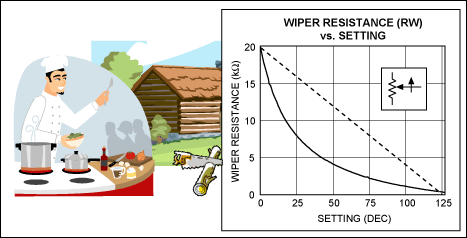

Pots, Pans, Logs, and Linear D
AD技术
11人已加入
描述
Pots, Pans, Logs, and Linear Digital Pots Create Arbitrary Voltage Curves |
Abstract: Linear digital potentiometers can be used to make arbitrary voltage curves and waveforms. An alternative name for a digital pot is a "string" digital-to-analog converter (DAC). Logging pots is the art of making a linear pot produce a logarithmic response for applications such as audio.
Figure 1 compares pots and pans with logs and log cabins. It also shows the linear and logarithmic plots of a digital pot (potentiometer).  Figure 1. Pots and pans, and logs vs. potentiometers; the plots of log and linear responses are resistance vs. pot position. The most popular electronic potentiometers (pots) are linear (Figure 1, dotted line). Due to their large sales volume, they tend to be among the less expensive pots. Nevertheless, other applications like audio require a logarithmic response (Figure 1, solid line) to match the human ear's response. The dichotomy of these responses inevitably leads to a designer's dilemma. How can we convert a linear response to logarithmic? Maxim application note 3996, "Logging the Linear Digital Potentiometer," provides the math to do the conversion. How, then, can we visualize the simple conversion? We will graphically illustrate a simple solution. As application note 3996 suggests, the minimum number of taps on the digital pot should be 128 or more. This number ensures that enough steps are available to keep the errors under reasonable control. With some thought we realize that half of the taps always represents 6dB. Consequently, the other half of the taps is the attenuations that are more than 6dB. We can use a 256-step digital pot as an example. The Maxim website has more than 30 different 256-step digital pots available. The pots have a variety of serial interfaces including I²C and SPI™, as well as up/down. The parts have both volatile and nonvolatile memories. An important parameter for audio use is the glitchless switching between taps found in the MAX5403/MAX5404/MAX5405 family of parts. To convert a linear pot to logarithmic we just skip certain steps. A 256-tap linear pot can provide 38 log steps with about ±1% accuracy. The steps in dB are 48, 42, 38.5, 36, 34, 32.5, and in 1dB there are steps from 31 to 0. A spreadsheet with the exact numbers is available for download. The spreadsheet also contains 0.5dB increments below the 32dB point. Using the same step-skipping method we can generate other arbitrary voltage curves. Thus we can compensate for other nonlinear responses such as sensors. For example, if a given sensor changes with temperature, we could sense temperature and compensate. An alternative name for a digital pot is a "string digital-to-analog converter" (DAC), which means that digital pots are specified with parameters like integral nonlinearity and dynamic nonlinearity. Now we return to the logs, pots, and pans, and can use our imagination to do creative designs. Usually designers do not need to sit at Lincoln's desk for inspiration, and logs do not always conjure up images of rustic cabins. However, we all can go into our own kitchen, grab a pot, create good food, and be inspired. |
声明:本文内容及配图由入驻作者撰写或者入驻合作网站授权转载。文章观点仅代表作者本人,不代表电子发烧友网立场。文章及其配图仅供工程师学习之用,如有内容侵权或者其他违规问题,请联系本站处理。
举报投诉
- 相关推荐
- 热点推荐
- Linea
-
PBSS4260PANS-Q NPN/NPN低VCEsat晶体管手册2023-09-26 309
-
60V,2A NPN/NPN 低 VCEsat(BISS) 双晶体管-PBSS4260PANS2023-03-03 337
-
linear 仿真2021-09-29 637
-
连接到标准POTS电话的最常用接口有哪几种?2021-05-31 6112
-
Linear拥有30年的模拟工程优势2019-05-20 2745
-
Linear LT3760的主要特性2019-03-18 2530
-
与Power By Linear的那些事2018-11-01 2194
-
Designing Linear Circuits for 5V Operation2011-12-30 706
-
LFC789D25,PDF(DUAL LINEAR FET2010-10-22 686
-
Linear Technology Corporation推2010-02-03 1112
-
Creating Non-Linear Transfer F2009-04-28 732
全部0条评论

快来发表一下你的评论吧 !

